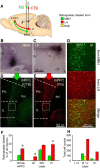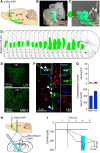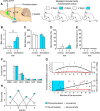Task Division within the Prefrontal Cortex: Distinct Neuron Populations Selectively Control Different Aspects of Aggressive Behavior via the Hypothalamus
- PMID: 29487128
- PMCID: PMC6596023
- DOI: 10.1523/JNEUROSCI.3234-17.2018
Task Division within the Prefrontal Cortex: Distinct Neuron Populations Selectively Control Different Aspects of Aggressive Behavior via the Hypothalamus
Abstract
An important question in behavioral neurobiology is how particular neuron populations and pathways mediate the overall roles of brain structures. Here we investigated this issue by studying the medial prefrontal cortex (mPFC), an established locus of inhibitory control of aggression. We established in male rats that dominantly distinct mPFC neuron populations project to and produce dense fiber networks with glutamate release sites in the mediobasal hypothalamus (MBH) and lateral hypothalamus (LH; i.e., two executory centers of species-specific and violent bites, respectively). Optogenetic stimulation of mPFC terminals in MBH distinctively increased bite counts in resident/intruder conflicts, whereas the stimulation of similar terminals in LH specifically resulted in violent bites. No other behaviors were affected by stimulations. These findings show that the mPFC controls aggressiveness by behaviorally dedicated neuron populations and pathways, the roles of which may be opposite to those observed in experiments where the role of the whole mPFC (or of its major parts) has been investigated. Overall, our findings suggest that the mPFC organizes into working units that fulfill specific aspects of its wide-ranging roles.SIGNIFICANCE STATEMENT Aggression control is associated with many cognitive and emotional aspects processed by the prefrontal cortex (PFC). However, how the prefrontal cortex influences quantitative and qualitative aspects of aggressive behavior remains unclear. We demonstrated that dominantly distinct PFC neuron populations project to the mediobasal hypothalamus (MBH) and the lateral hypothalamus (LH; i.e., two executory centers of species-specific and violent bites, respectively). Stimulation of mPFC fibers in MBH distinctively increased bite counts during fighting, whereas stimulation of similar terminals in LH specifically resulted in violent bites. Overall, our results suggest a direct prefrontal control over the hypothalamus, which is involved in the modulation of quantitative and qualitative aspects of aggressive behavior through distinct prefrontohypothalamic projections.
Keywords: aggression; hypothalamus; optogenetics; prefrontal cortex; rats; social behavior.
Copyright © 2018 the authors 0270-6474/18/384065-11$15.00/0.
Figures





References
-
- Beiderbeck DI, Reber SO, Havasi A, Bredewold R, Veenema AH, Neumann ID (2012) High and abnormal forms of aggression in rats with extremes in trait anxiety—involvement of the dopamine system in the nucleus accumbens. Psychoneuroendocrinology 37:1969–1980. 10.1016/j.psyneuen.2012.04.011 - DOI - PubMed
-
- Biro L, Toth M, Sipos E, Bruzsik B, Tulogdi A, Bendahan S, Sandi C, Haller J (2017) Structural and functional alterations in the prefrontal cortex after post-weaning social isolation: relationship with species-typical and deviant aggression. Brain Struct Funct 222:1861–1875. 10.1007/s00429-016-1312-z - DOI - PubMed
Publication types
MeSH terms
Substances
LinkOut - more resources
Full Text Sources
Other Literature Sources
Research Materials
Miscellaneous
